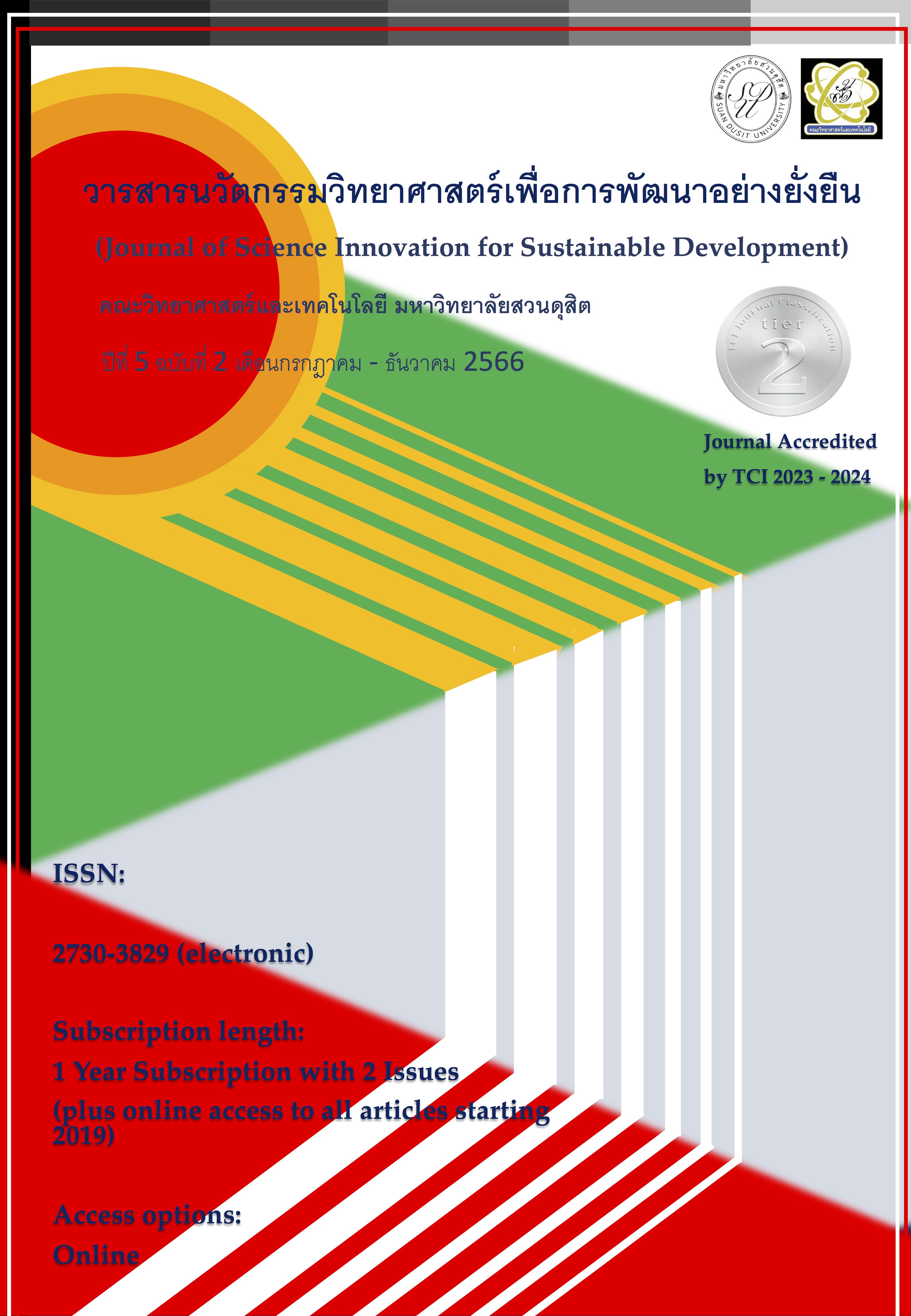Deep Convolutional Neural Networks and Image Processing for Classification of guppy gender and counting Narongrit Piromnok1,*, Surasit Songma1
Main Article Content
Abstract
This research aimed to 1) compare the effectiveness of using deep convolutional neural networks to classify the gender of guppy fish from images taken at different angles, and 2) test the efficiency of counting guppy fish using image processing technology with a dataset of 19,665 images captured in the real environment in Mueang Nakhon Pathom and Nakhon Chai Si districts, Nakhon Pathom province. The data were processed and analyzed using Python software with deep convolutional neural networks and image processing technology. The results revealed that the classification of guppy fish gender from side-view images using deep convolutional neural networks The highest average accuracy value was obtained: mAP = 0.98. This was followed by images that combined both top and side views, and then by top-view images, respectively. A detailed consideration found that side-view images provided the highest accuracy as they distinctly displayed the fish body, color, and tail fin. Furthermore, the efficiency of counting guppy fish using image processing technology with images taken under LED lighting resulted in a root mean squared error of 1.92, which is lower than images captured under natural light. This is because LED lighting allows clearer image captures and consistent light control throughout the day. The research outcomes can be integrated with hardware to develop a system for classifying gender and counting guppy fish. This will assist guppy fish breeders in accurately, swiftly, and effectively segregating by gender and counting their guppy fish populations.
Article Details

This work is licensed under a Creative Commons Attribution-NonCommercial-NoDerivatives 4.0 International License.
ลิขสิทธิ์ต้นฉบับที่ได้รับการตีพิมพ์ในวารสารนวัตกรรมวิทยาศาสตร์เพื่อการพัฒนาอย่างยั่งยืนถือเป็นกรรมสิทธิ์ของคณะวิทยาศาสตร์และเทคโนโลยี มหาวิทยาลัยสวนดุสิต ห้ามผู้ใดนำข้อความทั้งหมดหรือบางส่วนไปพิมพ์ซ้ำ เว้นแต่จะได้รับอนุญาตอย่างเป็นลายลักษณ์อักษรจากคณะวิทยาศาสตร์และเทคโนโลยี มหาวิทยาลัยสวนดุสิต นอกจากนี้ เนื้อหาที่ปรากฎในบทความเป็นความรับผิดชอบของผู้เขียน ทั้งนี้ไม่รวมความผิดพลาดอันเกิดจากเทคนิคการพิมพ์
References
Behera, S. K., Rath, A. K. and Sethy, P. K. (2021). Information Processing in Agriculture. 8 (2), 244–250.
Ćalasan, M., Abdel Aleem, S. H. E. and Zabaa, A. (2020). On the root mean square error (RMSE) calculation for parameter estimation of photovoltaic models: A novel exact analytical solution based on Lambert W function. Energy Conversion and Management 210 (2020). pp. 1–16.
Chaiwachiragompol A., Luangmaneerote S., Tasuntia J., Nabumroong B. (2022). Forecasting student
admissions using back propagation multilayer neural network model. Journal of Science Innovation for Sustainable Development, 4(1), 20–31.
Chutichaimetha, P., Kaewtrakulphong, K., Paosang, T., Sermsak, R., and Jesadathamsathi, S. (2022). Counting the number of crickets by digital image processing method for the community enterprise farming (Proceedings of 60th Kasetsart University Annual Conference: Plants, Animals, Veterinary Medicine, Fisheries, Agricultural Extension and Home Economics). Bangkok. pp. 302–308. [In Thai].
Gururaj, N., Vinod, V. and Vijayakumar, K. (2022). Deep grading of mangoes using Convolutional Neural Network and Computer Vision. [Online]. Retrieved November 11, 2023, from the website https://doi.org/10.1007/s11042-021-11616-2.
Indolia, S. Goswami, A.K. Mishra, S. P. and Asopa. P. (2018). Conceptual Understanding of Convolutional Neural Network- A Deep Learning Approach. Procedia Computer Science. 132, 679–688.
Khai, T. H., Abdullah, S. N. H. S., Hasan, M. K. and Tarmizi, A. (2022). Underwater Fish Detection and Counting Using Mask Regional Convolutional Neural Network. [Online]. Retrieved November 11, 2023, from the website https://doi.org/10.3390/w14020222.
Khamnipat, K. and Pramote, O. (2022). Convolutional neural networks for classification picture of a dahlia flower. National Academic Conference on Computers and Information Technology. 18th time (NCCIT2022), 19–20 May 2022 Phra Nakhon Si Ayutthaya: Faculty of Information Technology and Digital Innovation King Mongkut's University of Technology North Bangkok. pp. 19–24. [In Thai].
Nakhon Pathom Provincial Fisheries Office. (2023). Important aquatic animals and the market that receives the produce. [Online]. Retrieved November 14, 2023, from the website https://www4.fisheries.go.th/local/index.php/main/view_blog2/58/70324/2374. [In Thai].
Nakvijitpaitoon S., and Tanawong T. (2022).The Analysis System of Assessment of Smartphones Pawned with Deep Learning. Journal of Science Innovation for Sustainable Development, 4(2), 27–39.
Rathi, D., Jain, S. & Indu, S. (2017). Underwater fish species classification using Convolutional Neural Network and Deep Learning. 2017 Ninth International Conference on Advances in Pattern Recognition (ICAPR). IEEE, India. pp. 1–6.
Raya. W. (2015). Breeding of guppies. Kasetsart News, 60(2). pp. 9–25. [In Thai].
Rodloi, A. (2022). Handbook for guppies cultivation in Thailand. Bangkok: Wanida Printing
Limited Partnership. pp. 3. [In Thai].
Shah, D. (2022). Mean Average Precision (mAP) Explained: Everything You Need to Know. [Online]. Retrieved November 13, 2023, from the website https://www.v7labs.com/blog/mean-average-precision.
Suvarnabhumi Airport Aquatic Animal Checkpoint. (2021). Statistics on import and export of fish at Suvarnabhumi Airport. [Online]. Retrieved November 15, 2023, from the website https://www4.fisheries.go.th/local/index.php/main/view_qr_group/178/1436. [In Thai].
Thipchote, M. and Kokaew, U. (2021). Studied the subject of analysis of Mudmee silk of Khon Kaen Province by Convolutional Neuron Networks. 13th ECTI-CARD 2021 National Conference. "Innovation for a sustainable society" pp. 294–297. [In Thai].


